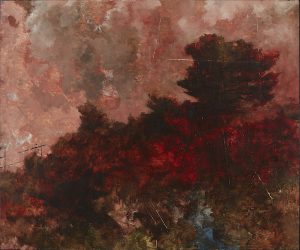Review: ‘The Botanical: Beauty and Peril’ ·
Art Gallery of Western Australia ·
Review by Miranda Johnson ·
This incredibly diverse exhibition guides the viewer on a journey through more than 200 works that progressively instill a sense of wonder at the richness of the natural world.
This wonderment is used as a vehicle to gently remind us of the threat and peril of the exhibition’s title – a doubling of hope and danger, two sides of a single coin.

Traversing historical and contemporary attitudes towards our natural world, “The Botanical: Beauty and Peril” seeks to address the progressively increasing sense of despair, loss and anxiety related to environmental destruction. It positions our current ecological circumstances within a historical context to help understand how we came to be facing a climate emergency.
The exhibition is drawn from the State gallery and from that of its chair, Janet Holmes à Court, and is co-curated by AGWA’s Melissa Harpley and the Janet Holmes à Court Collection’s Laetitia Wilson and Megan Schlipalius.
It takes a narrative form, allowing the viewer to walk through sections dedicated to different periods of human investment, impact and relationship with the botanical world. Beginning with European botanical illustrations by artists including Margaret Forrest and Florence Hildegarde Bassett alongside Aboriginal representations of Country by Emily Kam Kngwarreye, this rich, immersive show drives home the importance of representing the natural world as a way to understand, experience, and find one’s place within it.
Walking clockwise through the exhibition, the narrative shifts from human representation of the landscape to our effect upon it. We see works reflecting the impact of logging, the politics of Aboriginal land rights and ongoing European settlement expressed in such works as brightly illustrated posters advertising Western Australia as a desirable place to travel and live.

wood, plastic, steel, synthetic polymer paint, feathers, plant fibre and shell, 200 x 350 x 50 cm, State Art Collection, Art Gallery of Western Australia. Purchased through The Leah Jane Cohen Bequest, Art Gallery of Western Australia Foundation, 2014, © Brian Robinson, 2013.
A particular highlight are the 18 hanging batik fabrics by Utopia women artists in the 1980s, an injection of joyful colour and pattern displaying important plants and vegetables used for food and medicine. Here, the joy of making aligns with the love of country and an understanding of the connection between human survival and a bountiful land.
Although the exhibition follows a theme of the destructive effects of human intervention on the landscape, the works themselves are not presented chronologically. Alongside botanical illustrations from the 19th century, Eva Fernandez’s Flora Obscura series (2013) seeks to replicate the look of these early studies of WA flora. This makes for thoughtful juxtapositions of contemporary and historical works that speak to one another across the decades.

“The Botanical” does not shy away from stark reminders of our uncertain future, its strength lying it its focus on the double-sided nature of nature itself, as something beautiful yet also dangerous. Through subtle revelations of the dark side of the natural world, including extinction and bushfires, the exhibition hints towards danger and destruction, but stops short of paralysing viewers with fear, leading to inaction.
In its balance of light and dark, beauty and danger, as well as the associated series of public programs aiming to stimulate conversation and education around climate change, the exhibition is successful in its gentle push towards consideration of and care for our natural world, with just enough of a hint of a threat to encourage you into action.
“The Botanical: Beauty and Peril” runs until November 4.
Pictured top: Eva Fernandez’s digital print Flora obscura 14 (detail).
On loan from the Janet Holmes à Court Collection.
Like what you're reading? Support Seesaw.






